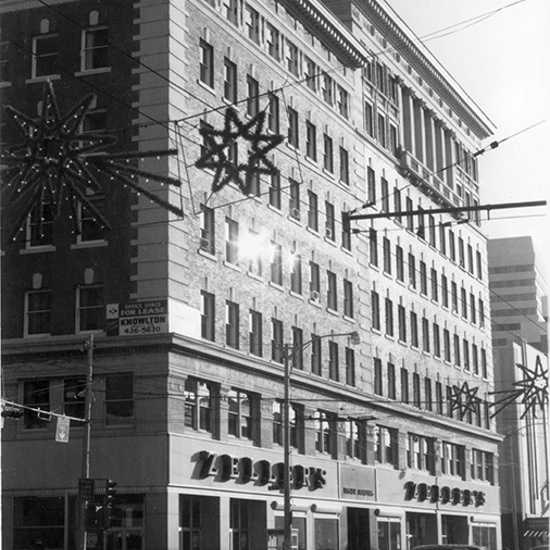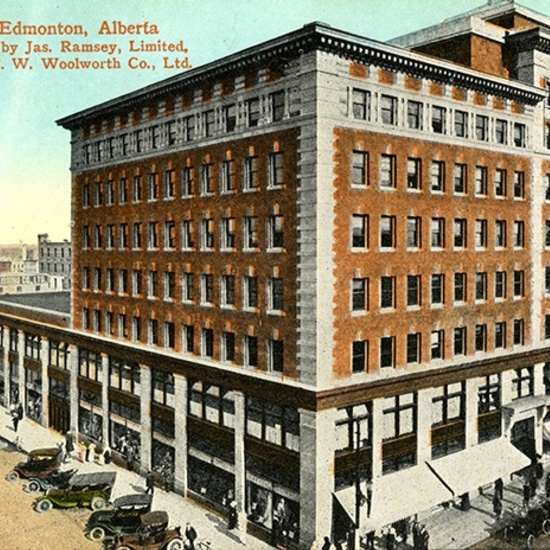Tegler Building
For seventy years the Tegler Building represented the hub of Edmonton's downtown. Its controversial demolition in 1982 precipitated a civic preservation strategy.
For seventy years the Tegler Building represented the hub of Edmonton's downtown. Its controversial demolition in 1982 precipitated a civic preservation strategy.
This Edwardian building was the inspiration of Robert Tegler in 1911. Strongly symmetrical, the details of the Tegler Building included red brick cladding with white stone corner quoins, contrasting keystones highlighting the many single-sash windows, a top-floor balustrade, and a handsome dentilled cornice. At seven storeys-two storeys higher than any other at the time-the office tower dubbed "Edmonton's skyscrapper" by the Edmonton Bulletin. The department store on the main level and 110 office rooms above were designed by the architects Magoon and MacDonald and built by the contractor George A. Archibald Company who used the last technologies to make it entirely of reinforced concrete- the first fireproof building in Edmonton. The main entrance featured marble and mosaic tile, the elevator had grills of the finest design in bronze, while the office details were finished in oak. Said the Bulletin, "a block of this character would not be erected if the future were not regarded hopefully and soundly."
Tegler took advantage of this optimism to secure the lease for Ramsay's departement store in the basement and first level while the building was still in the design phase. Edmonton's soaring need for retail and office space meant that Tegler commissioned and addition holding 700 more offices within a year of the first portion being built. Tegler's dream was an impressive success from the start, with one hitch: the old Edmonton Journal building sat right where Tegler's addition was planned, but the Journal wouldn't leave their premisses until the construction of their new building was complete. Tegler's solution? He built the eight-storey addition above the Journal offices from the third floor up; once the newspaper vacated and the old building demolished, construction continued down from the third to ground level. The conjoined buildings at the corner of Elizabeth Avenue and First street measured 70x106 feet and 140x 100 feet, covering most of a city block, becoming the largest office building in the city. Its popularity effectively shifted the core of downtown from 97th Street and Jasper to 101 Street and 102 Avenue.
Robert Tegler never married and lived frugally, renting a room at the YMCA at times. His real estate investments weathered the devastating recession of 1913 and he died of ill health in 1921-a millionaire at 44 years of age. Mourners were full of respect and affection for Tegler, "one of few who lived and died without an enemy". His legendary generosity continued after he was gone: the Robert Tegler Trust fund established through terms of his will created the first charitable trust in Alberta.
The demise of the Tegler Buiding was not so gracious. In 1978 the Bank of Montreal purchased the Tegler Building in order to construct an office tower on the site. A bitter four-year battle ensued between the bank, the City, and public opinion. Those opposed to the demolition of the Tegler building fought for the preservation of an historic icon, the bank countered these claims insisting that it would lose millions in revenue without a new building. In the end the City relented rescinding a bylaw which would have declared the Tegler an historic resource. The building was demolished in 1982. Following this saga, City Council came up with heritage preservation measures in an attempt to avoid the loss of other historic resources in Edmonton.
Details
Type
Commercial
Designation Status
Demolished
Neighbourhood
Time Period
Year Built
1911
Architects
Architectural Styles
Character Defining Elements
Balcony , Balustrade , Brick cladding , Columns , Cornice , Entablature , Flat roof , Keystone , Pilaster , Quoins , Rectangular footprint , Reinforced concrete structure , Stone cladding , String course , Three storeys or more

